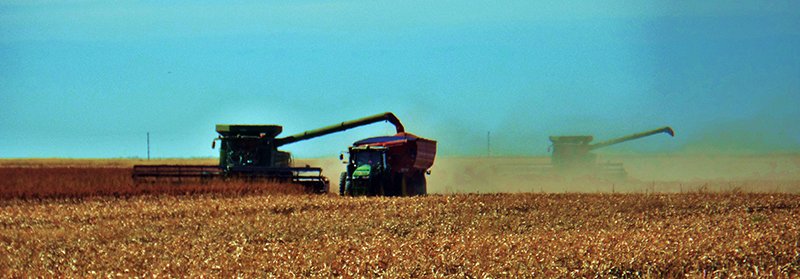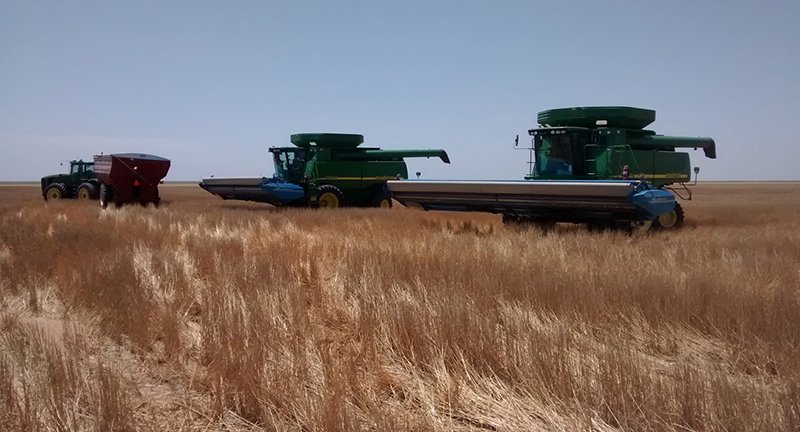Case studies of some top-notch no-tillers (there are many).
The Oklahoma/Texas Panhandle is an exceptionally harsh environment for growing dryland crops, and despite being plenty dry most of the time, no-till isn’t the no-brainer that you might guess it to be. Indeed, the dryness, lack of cropping options, glyphosate- & dicamba-resistant kochia, and the struggle to maintain enough mulch to prevent blowing in their 60 – 70 mph winds are sufficiently challenging that only a very few have made long-term no-till work. Scott Arthaud is one of them—the only one in his area. Growing only two crops in three years using some wheat >>milo >>summerfallow rotation is routine in their area, but everyone v-blades the fallow at least once—except Scott.
Scott’s dad had tried no-tilling milo into wheat stubble in ’82 or ’83, but they just didn’t have the equipment to make that practice work. When Scott came back to the farm in ’95, no-till seeding technology had advanced enough that they were able to make a habit of planting milo directly into the previous year’s wheat stubble. But they still v-bladed in the fallow year, until 2001 when Scott bought a JD 1850 drill and started no-tilling the wheat as well (into summerfallowed milo stalks). Scott admits to being stubborn about no-till, but he also harbors doubts about it. He thinks he’s lagging financially behind the best farmers who v-blade, mostly because his herbicide costs are too high now that glyphosate- & dicamba-resistant kochia have blown up. Scott says he definitely spent too much in 2015 & 2016 on herbicides, with much of that learning how to use paraquat and having some control issues. He’s also plenty focused on sanitation—attempting to not let any weeds go to seed. But Scott bought a WEEDit (modern version of a GreenSeeker with much better technology) in early 2017 and is very optimistic. Scott says the WEEDit allows him to cut his herbicide costs in half in summerfallow, which he predicts will put him “on-par or below what it costs to operate a v-blade.” The WEEDit typically applies anywhere from 3% to 20% of what a broadcast application would require, although Scott will likely continue using some soil-applied chems in his summerfallow, and some sprays are still broadcast, so he calculates it’ll end up being a 50% reduction in total herbicide costs for fallow. WEEDit also accommodates the use of stronger herbicide mixes. Plus, he gets to keep all the benefits of being continuous no-till. As for the benefits of no-till, Scott says, “Yield-wise, I’m not beating my neighbors by any substantial amount if at all.” But he points out that their area had a 3- to 5-inch rain event in May 2016 that caused a lot of erosion in anything that was v-bladed, while his continuous no-till had very little damage from that storm. Scott says their long slopes can create major scouring off of soil if the water starts moving. He also points out that their no-till fields were far more traffickable this last summer than where v-blading in recent years created restrictive layers that kept the soil surface mucky (granted, too wet is quite a rarity for them). Still, he must be doing something right, since he’s almost quadrupled his cropland in 22 yrs, starting with 4,000 acres of dryland (rain-fed) cropland in the mid-’90s with his dad, to 12,000 acres of dryland plus 3,000 acres of irrigated today. Most of their acres are rented, so there’s not a big pile of equity to keep him afloat.
Just how dry is it? Well, corn isn’t insurable in their area. Scott’s long-term average for wheat on summerfallow is approx 35 bu/a. “Stubble-back” wheat (wheat on wheat) makes 20 – 50% less, depending on how dry it is. The best wheat he’s ever had made 84 bu/a, with a farm average of about 60 that year. Milo makes somewhere between zero and 100 when planted into wheat stubble, but usually 30% less if it’s milo on milo—and the weeds are worse, especially grassy sandbur. In 2011, the milo failed completely—but from Aug 2010 to Aug 2011, he had only 4 inches of precipitation in total for the entire 12 months! One saving grace is that he’s at 4,000-ft elevation, so his nighttime temps cool off nicely. Some of his soils are deep—mostly clay loams, but a few of his better soils are a touch sandier. However, plenty of his cropland has caliche layers that limit rooting and yields.
Getting rid of the summerfallow is something Scott would love to do—but drilling wheat directly after milo harvest usually isn’t feasible because it’s too dry, or too late, or both. Late-planted wheat is a hazard for him, because of those screamer winds that rip through his area from late November till May. He needs the wheat to get up and cover the soil or he’ll have blowing, since his drill (a 60-ft JD 1890 on 10-inch spacing with narrow gauge wheels) flattens too much of his milo stalks—which are already quite fragile from 10 – 11 months of decomposition by that point. (And their milo yields aren’t such that huge biomass is being generated anyway.) Scott says it took him a long time to come to grips with the reality that his no-till fields were more prone to blowing than the neighbors’ that got v-bladed every third year: “They bring up clods, which persist. My soil surface is perfectly flat, and the surface inch or so is very loose when it gets dry.”
Towards the goal of eliminating summerfallow, Scott has drilled oats in Feb on various occasions in the past 20 years, for hay, grain, or merely a cover that’s terminated with herbicides. He’s since quit taking hay, since he couldn’t afford the loss of mulch. Where Scott takes the oats for grain, he incurs a yield hit on the wheat just like if it was 2d-yr wheat—mostly due to moisture, although nutrient tie-up may be playing a secondary role in both cases. Also, he has no viable local market for grain oats, especially with low test weight which is inevitable in the hot/dry conditions. Scott’s issue with doing oats every year as a cover-crop is that quite a few years, it’s simply too dry to germinate them—and he dares not dust them in, for fear of the field blowing. Even if he can get them established, they grow slowly, and it takes a while for them to get enough size to protect the field from blowing during fierce springtime winds. “Right after drilling is our most exposed time.” He muses whether he should switch over his JD 1890 to 15-inch spacing to keep more stalks standing. One discovery this year was that by going at a 10- or 20-degree angle to the old milo rows, he kept a lot more stalks standing across the field.
For another tool in his kit, Scott contemplates using cereal rye in the late fall after milo harvest, since sometimes he has moisture near the surface then, but not always in Feb/March for oats. Although he knows his rotation (and the neighbor’s rotations) would never allow rye to become a weed issue for them, he still has mental hangups about planting it. He’s tried a few other broadleaf cover crops on small acreages, but those failed utterly due to lack of moisture in the winter. But if he could make rye or oats work as a cover, he would probably forego the residual herbicides that he applies in Feb in the summerfallow to hold down the kochia. Still, he will probably never get rid of summerfallow completely, since it’s just too risky in their dry climate: “I’m always impressed at just how much moisture we can bank in the soil, and just how deep the crop will go to get it.” On the deeper soils, that is.
So, wheat (or winter barley) >>milo >>summerfallow is the system Scott’s managing around, for the foreseeable future. Wheat (or barley) gets MESZ pop-up with the drill, and ~ 35# additional N as surface-applied urea, usually in the spring, although this year he broadcast some acres ahead of drilling. He says that in dry years, he wishes he wouldn’t have put any N on, but in the good years, he still has enough to grow 70 – 80 bu/a wheat. This isn’t surprising on summerfallow, especially in such a dry area that experiences very little leaching & denitrification, so the efficiency is high. Also, their soils haven’t been beat to death with as much tillage as some areas, and total crop removal as grain is fairly low. Scott says he almost never sees visual signs of N def in any of their crops, although 2017 was an exception where his zero-rate check strips did show up both visually and in yield. Scott says it’s sometimes tempting to apply more N in the years that look like they’ll have enough moisture but concludes that it’s too nerve-racking since too often those years that start out with good prospects turn hot and dry at heading or grain fill, or they get wacked with a hailstorm. He would rather not ride that roller-coaster of emotion and just keep a steady rate every year: “It seems like we spend so much willpower [trying to predict, and stay on-budget]. It’s nice to just do the same rate every year” and plan for average conditions.
For a long time, Scott had an Exactrix NH3 setup on his drill but removed it in 2017: “It slowed down planting too much, and we couldn’t plant without applying NH3 or the nozzles would plug. It’s so much nicer to not have that hassle anymore. And we get better seed placement without Exactrix on there—I didn’t realize how much those wings were disrupting seed placement.”
Scott’s drill is equipped with Exapta’s UniForce (hydraulic downforce on the openers, replacing the coil springs), which he really likes: “In marginally dry conditions, it’s a big advantage. The row units hold depth better—it’s impressive to look back there and see the row units not bouncing [like they would with OEM springs].” His drill is also outfitted with Exapta’s Ninja seed bounce flaps, Thompson closing wheels, and slowly getting outfitted with DuraLok seed-lock wheels as the JD ones fail. He had another brand of spoked closing wheel, but didn’t get along as well with them. He says the OEM beveled cast wheel actually works pretty good in their soils, if only it didn’t bounce so much. They run their drill about 6.5 mph, and while Scott remarks that they could go faster now with UniForce, the drill struggles a bit to deliver that much product out to the wings anyway without really cranking the fan speed up.
Most of Scott’s milo goes in with their 24-row JD 1770 planter on 30-inch spacing. If they get behind, their drill is enlisted to help—but usually that milo is also on 30-inch spacing (he might do some 20-inch in 2018). The milo gets NH3 at planting time, approx three inches away from the row via Dawn hydraulic-controlled coulters on the planter. Scott also tows another air cart with the planter to deliver dry P fertilizer either in the seed row or in the sideband. He prefers NH3 because it’s so very cheap in their area. (Not so much an issue on dryland at those low rates, but a big deal on his irrigation.) At one time, he had Martin UMO fertilizer openers that bolted to the front of the row unit—he says these worked great, except when it got dry and would take away downforce that he needed to keep the seed openers running at the correct depth. He also didn’t like the twist they applied to the parallel link.
For seed placement, Scott’s planter is set up with old-school pin-adjust Martin row cleaners. He previously had floating Martins, which he didn’t like. He likes the simplicity of the pin-adjust and sets them so they’re not even turning all the time—which is probably about right since their wheat and barley has all been harvested with a Shelbourne for the past 5 years or so, and usually isn’t particularly heavy stubble and stays standing fairly well in their dry climate. Row-unit downforce is with air bags, although he really wants to go to hydraulic. He carries some extra weight on the wings (not surprising, since he still has sideband openers to hold in the soil, even if they’re not attached to the row units now).
Scott’s planter also features Valion seed tube guards to limit blade flex, and he notes that they sure last a lot longer than OEM. His planter finishes the job with Keetons + Mojo Wires for seed firming, and Thompson closing wheels with toe-out wedge. He says he really got along fairly well with Martin Spaders and drag chains, except for the bearing problems they had—and is very pleased that Thompson wheels don’t have any bearing issues.
On Scott’s irrigated acres, some of it is continuous corn using strip-till. And where the wells are very limited, it’s a rotation of wheat (or barley) >>corn >>milo >>sunflower. He’s tried canola a few times, with mixed success.
Scott says, “I sometimes curse the irrigation—all the extra equipment and labor—but it’s our bread and butter. Although I’m tempted at times to just get rid of all the irrigated acres—we spend a lot of time on them.”
Scott has tried dryland corn, but the yields aren’t very competitive with milo, and corn doesn’t produce enough stalks for his liking. Although weed control is more challenging in milo, so he often runs a hooded sprayer on some of his milo acres.
Scott continues to adapt, noting that what he thinks he knows is often the biggest hurdle to overcome: “I should experiment more, rather than thinking I know the answer.” He says he certainly doesn’t feel like a model no-tiller: “It’s much harder than I thought it would be.” Still, he is reasonably confident he’s on the right track, noting that his “fields that’ve been no-till the longest have the best soil condition.” And that he can still see the damage from v-blading 20+ yrs ago on his fields—when dry, that layer is still identifiable, even though roots are growing thru it. Overall, Scott is stoked that WEEDit will allow him to continue his no-till program while greatly improving his bottom line.
For more info on WEEDit, see our newsletter, Tillage vs Technology.



